
If you're looking for a tree to provide shade over your patio or garden, a tree that looks like an umbrella might be an appropriate choice. Trees with this growth habit tend to have abundant foliage that provides a sunblock with its compact or spreading crown form. These trees are also often ornamental and work as garden or landscape specimens. Some, like the Capulin Cherry, even produce tasty fruit.
Fast Growing Capulin Cherry
Video of the Day
The Prunus Salicifolia is commonly referred to as the Capulin Cherry. It's native to the valleys of Sonora, Mexico to Chiapas, Veracruz and western Guatemala. In the 21st century, it's cultivated in California and South America. The tree has a short, squat trunk with an umbrella-shaped crown. The entire tree reaches 10 feet in only one to one and a half year's time. Its leaves are aromatic and deep glossy green in color when mature. Young trees have a rose color to them. Capulin cherry blossoms in early spring, producing white flowers. Half this tree's fruit falls before it has a chance to mature. Fruit ripens between May and August and has a sweet taste. Capulin cherry must be two to three years old before it produces fruit. It enjoys full sun and should be staked for wind protection. The tree is drought tolerant but thrives with an irrigation system set up. It also prefers a small amount of nitrogen fertilizer when it begins to flower in the spring.
Video of the Day
Acacia Tortilis: Small Umbrella Tree
The Acacia Tortilis, or Hayne tree, is a wide-spreading umbrella-shaped tree native to the Africa and the Middle East. This may be the smallest tree that looks like an umbrella. It grows to about 13-feet tall. Under extremely arid conditions, it only grows to 3-feet tall. Depending on the variety, branches may be white, narrow and straight or gray with black tips. This flowering tree produces blossoms that range from white to cream hues. It's generally used for firewood, though it's avoided in Malawi because it is thorny and difficult to handle.
Japanese Elm: Spreading Umbrella Habit
The Japanese elm grows in a spreading umbrella shape and is native to Japan and northeast Asia. Dark green (yellow in fall months) leaves grow 3 to 4 inches long to form a crown with a round head. This crown can reach 35- to 55-feet tall. Like its crown, the Japanese elm's root system grows in a spreading habit. Its size and growth habit makes it an appropriate windbreak. This tree likes moist, well-drained soils with loam composition. It thrives in pH levels between 5.5 and 8.0 and is hardy down to USDA zone 2. It's moderately drought tolerant. Japanese elm has more resistance to Dutch elm disease than other types of elm.
Bee Bees: Small Weeping Trees For Landscaping
The bee bee tree, or Korean evodia, isn't well-known to laymen, but probably should be. This small, pretty ornamental tree typically reaches 25 feet tall, but occasionally may top out at around 40 feet. As its name suggests, honey bees love this tree for its clusters of creamy white blossoms that appear mid- to late summer, when few other trees are blooming. Other pollinators favor this deer resistant plant, as well. Bees will visit your bee bee tree by the buzzing hordes, and will noisily announce their presence to you. Plant this attractive specimen tree in partial shade or full sun.